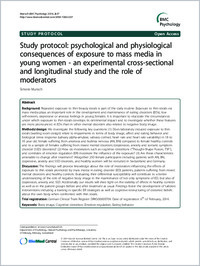Study protocol: psychological and physiological consequences of exposure to mass media in young women - an experimental cross-sectional and longitudinal study and the role of moderators
- Munsch, Simone Universität Fribourg, Schweiz
-
20.09.2014
Published in:
- BMC Psychology. - 2014, vol. 2, no. 37, p. 1-13
English
BACKGROUND: Repeated exposure to thin beauty ideals is part of the daily routine. Exposure to thin ideals via mass media plays an important role in the development and maintenance of eating disorders (EDs), low self-esteem, depressive or anxious feelings in young females. It is important to elucidate the circumstances under which exposure to thin ideals develops its detrimental impact and to investigate whether these features are more pronounced in EDs than in other mental disorders also related to negative body image. METHODS/DESIGN: We investigate the following key questions: (1) Does laboratory induced exposure to thin ideals (waiting room design) relate to impairments in terms of body image, affect and eating behavior and biological stress response (salivary alpha-amylase, salivary cortisol, heart rate and heart rate variability) in 18 to 35 year old female suffering from anorexia and bulimia nervosa (AN, BN) compared to female healthy controls and to a sample of females suffering from mixed mental disorders (depression, anxiety and somatic symptom disorder (SSD) disorders)? (2) How do moderators such as cognitive distortions ("Thought- Shape Fusion, TSF"), and correlates of emotion regulation (ER) moderate the influence of the exposure? (3) Are these characteristics amenable to change after treatment? Altogether 250 female participants including patients with AN, BN, depressive, anxiety and SSD disorders, and healthy women will be recruited in Switzerland and Germany. DISCUSSION: The findings will provide knowledge about the role of moderators influencing the effects of exposure to thin ideals promoted by mass media in eating disorder (ED) patients, patients suffering from mixed mental disorders and healthy controls. Evaluating their differential susceptibility will contribute to a better understanding of the role of negative body image in the maintenance of not only symptoms of ED, but also of depression, anxiety and SSD. Additionally our results will shed light on the stability of effects in healthy controls as well as in the patient groups before and after treatment as usual. Findings foster the development of tailored interventions including a training in specific ER strategies as well as cognitive restructuring of distorted beliefs about the own body when confronted with thin ideals.
- Faculty
- Faculté des lettres et des sciences humaines
- Department
- Département de Psychologie
- Language
-
- English
- Classification
- Psychology
- License
-
License undefined
- Identifiers
-
- RERO DOC 323597
- DOI 10.1186/s40359-014-0037-0
- Persistent URL
- https://folia.unifr.ch/unifr/documents/307182
Statistics
Document views: 152
File downloads:
- Texte intégral: 167
